In this article:
Cholesterol deposits can sometimes form yellow bumps or growths on the eyelids. This skin condition is medically known as xanthelasma palpebrarum.
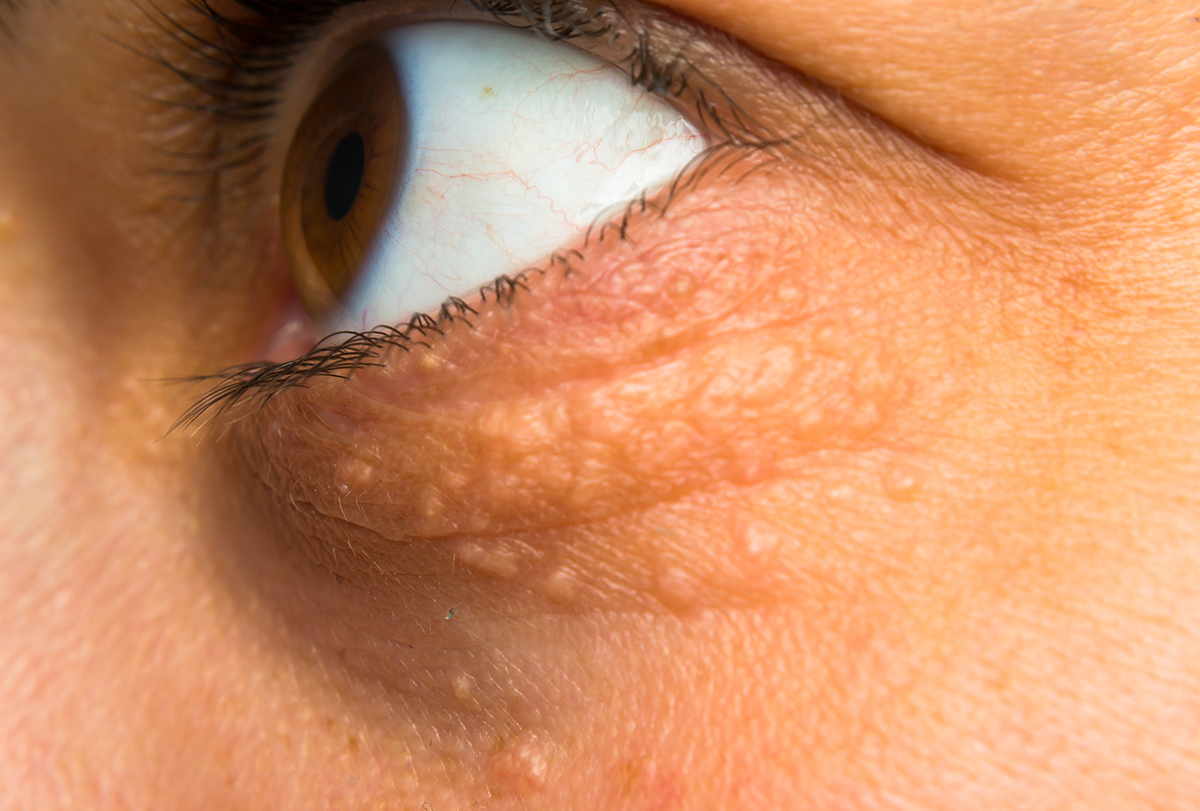
Cholesterol deposits around the eyes are usually a symptom of hyperlipidemia or heart disease. They are yellowish in color and occur when excess fat in your body starts collecting under the skin. They are more commonly seen in middle-aged people, although they can occur at any age. (1)(2)
Although these growths are mostly harmless, they can be pretty prominent and embarrassing for the people suffering from them. (3)
This article will discuss the causes of xanthelasma and its treatment.
Home Remedies to Prevent Cholesterol Depositions
Here is a list of affordable and easy home remedies you can try to lower your cholesterol deposits and improve your general health:
1. Garlic
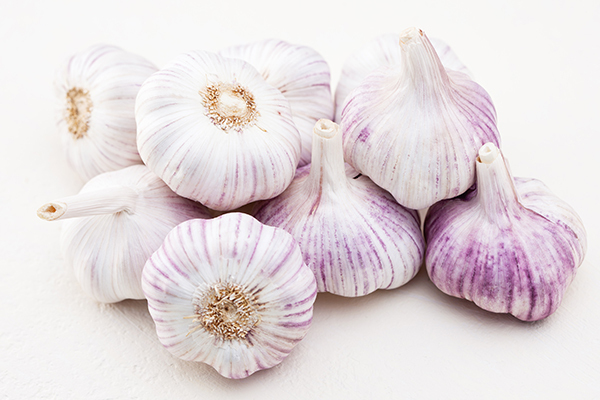
Garlic contains a compound known as allicin, which can help treat a number of health issues. It is especially beneficial for lowering cholesterol levels in the body. (4)
How to use:
Consume half a garlic clove or one whole garlic clove every day. (5)
2. Banana peels
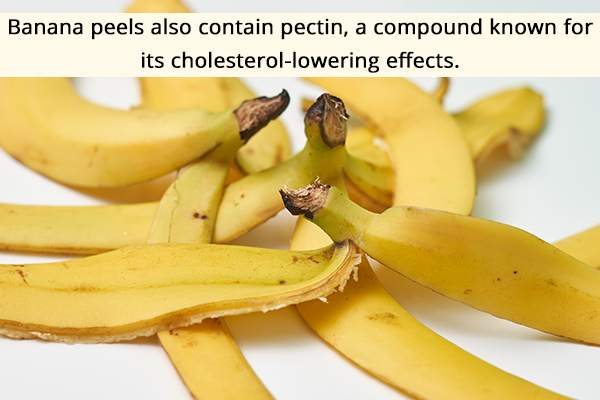
Banana peels are rich in vitamins C and E. Vitamin C is a potent antioxidant that can help reduce cholesterol levels in the body.
Banana peels also contain pectin, a compound known for its cholesterol-lowering effects. (6)(7)
3. Green tea
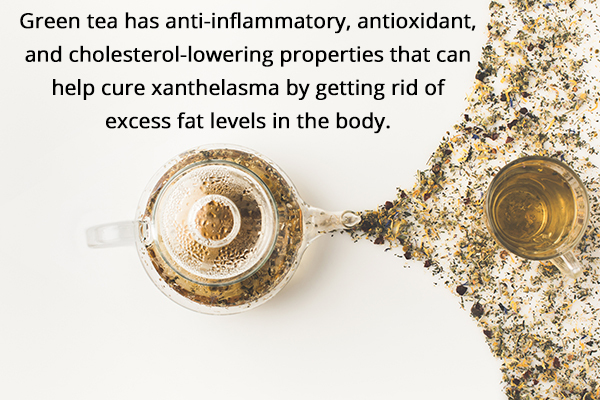
Green tea contains catechins, compounds that have several benefits for your health. They have anti-inflammatory, antioxidant, and cholesterol-lowering properties that can help cure xanthelasma by getting rid of excess fat levels in the body. (8)(9)
How to use:
- Drink a cup of green tea once or twice a day.
- Do not discard used teabags. Refrigerate them for 10 minutes and apply them over your eyes. Green tea contains anti-inflammatory properties and antioxidants that can reduce the yellow growths on your eyelids.
4. Fenugreek seeds
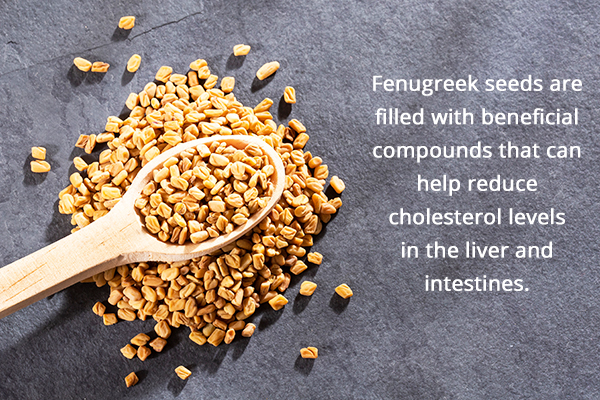
Fenugreek seeds are filled with beneficial compounds that can help reduce cholesterol levels in the liver and intestines. Several studies have demonstrated the positive effects of fenugreek when it comes to lowering lipid levels in the body. (10)
How to use:
- Consume 100 g of fenugreek seed powder daily.
- Soak a handful of fenugreek seeds in a glass of water and let them sit overnight. Drink the water in the morning.
5. Coriander
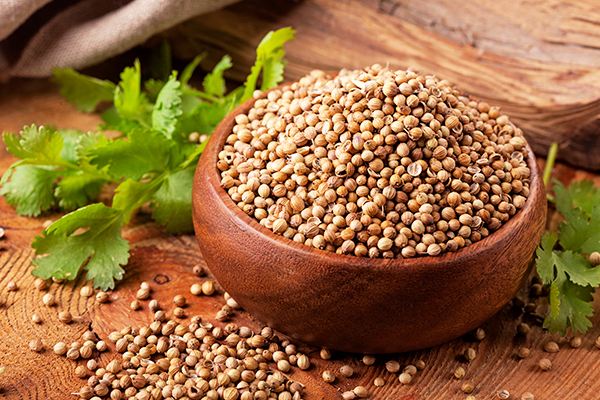
Coriander is a powerful medicinal herb that is filled with antioxidants that can help reduce cholesterol deposition in the body. (11)
How to use:
- Take a handful of coriander seeds and boil them.
- Let it simmer for 15 minutes before turning off the heat.
- Strain and drink the coriander tea once or twice a day.
Lifestyle Modifications to Manage Cholesterol Deposits Around the Eyes
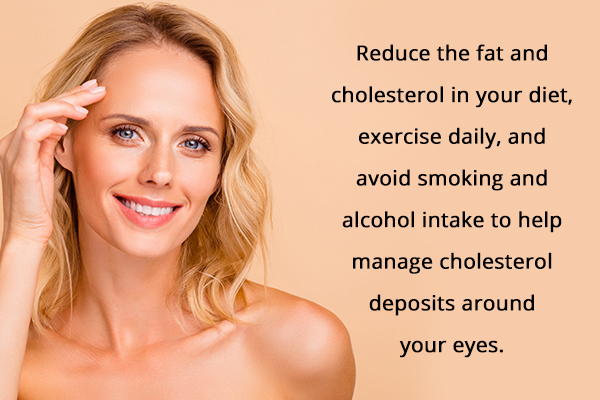
Here are some easy lifestyle changes that can help to manage cholesterol deposits around your eyes:
1. Reduce the fat and cholesterol in your diet
Changing your dietary habits can go a long way in reducing cholesterol levels in the body. (12)
Reduce your intake of red meat, fatty food, fried food, sugar, and processed food items. Instead, consume fruits such as oranges, berries, and kiwi, leafy green vegetables, plant-based oils, and whole grains. (13)
2. Exercise daily to remove the extra deposition of fat and to lose weight
Physical exercise can help decrease fat deposits in the body and improve blood circulation, reduce cholesterol, and get rid of xanthelasma. (14)
3. Avoid smoking and alcohol intake
Overconsumption of alcohol and smoking are two of the main causes of excess cholesterol levels and heart disease. It is never too late to quit an addiction. Seek professional help if required, and stop consuming these harmful substances.
Treatments to Get Rid of Cholesterol Deposits Around the Eyes
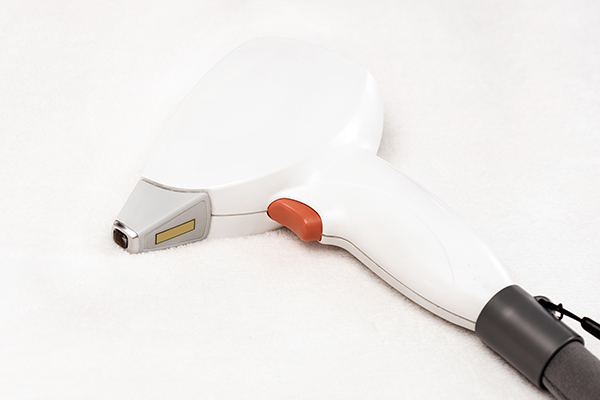
Cholesterol deposits around the eyes are stubborn growths and usually need to be treated medically. The treatment is aimed at reducing the cholesterol levels in the body. The most common treatments prescribed by doctors for xanthelasma include:
1. Surgical resection (surgery)
Your doctor can perform minor surgical excisions around the eyes to remove the fat deposits and get rid of the growths. (15)
Side effects: Your eyelids are delicate and surgeries involving them can have complications.
2. Laser treatment
Laser treatment is an effective nonsurgical alternative to surgery. It involves the use of ablative lasers such as carbon dioxide or argon laser.
Side effects: Laser treatment can sometimes lead to hyperpigmentation, scarring, or eye injuries.
3. Cryotherapy (freezing method)
Cryotherapy can be useful for some cases of xanthelasma. It involves the use of nitrous oxide gas and requires multiple sessions to show benefits.
Side effects: Repeated cryotherapy can lead to severe scarring.
4. Chemical peels
Chemical peels utilize trichloroacetic acid (TCA) in a high percentage of 50% or above to reach the optimum depth for the cholesterol deposits in the inner layer of the skin.
Chemical peels are a recently approved treatment for cholesterol deposits around the eyes. They work by using TCA to dissolve the fat and get rid of the growths.
Side effects: Chemical peels can lead to hyperpigmentation in some people.
5. Radiofrequency ablation
Radiofrequency ablation is safer and more effective than most other techniques used to cure xanthelasma.
Side effects: Radiofrequency ablation can lead to some pigmentation and scarring.
6. Lipid-lowering medications
Certain medications that help lower lipid levels in the body (such as atorvastatin, lovastatin, and simvastatin (16)) can help treat or reduce cholesterol deposits around the eyes. (16)(15)
Diagnosing Cholesterol Deposits Around the Eyes
Doctors can usually diagnose xanthelasma by observing the growths around your eyes. You may be asked to undergo a few blood tests to determine the exact cause behind it.
Causes of Cholesterol Deposits Around the Eyes
Nearly half of all people suffering from xanthelasma have the following lipid disorders: (15)
1. Type II hyperlipidemia/familial hypercholesterolemia (high level of LDL)
If you experience cholesterol deposition around your eyes in early childhood, you likely have type 2 hyperlipidemia, which is a genetic disorder that causes high levels of low-density cholesterol in the blood. Low-density cholesterol is harmful to your general health and can cause heart disease in the long term.
Xanthelasma in young children is an indicator of type 2 hyperlipidemia and should be evaluated by a doctor at the earliest. (17)
2. Type IV hyperlipidemia/hypertriglyceridemia (dyslipidemia; high level of VLDL)
Type 4 hyperlipidemia is caused by excessive production of very-low-density lipoproteins in the liver. This can lead to excess fat deposits in the body. (18)
Other health conditions that can cause cholesterol deposits around the eyes are:
- Diabetes
- Excessive alcohol consumption
- Obesity
- High blood pressure
- Inflammation
Characteristics of Cholesterol Deposits Around the Eyes
Cholesterol deposits around the eyes are usually described as follows:
- They appear as asymmetrical, yellow bumps that can merge to form larger ones.
- These bumps tend to appear near the inner corners of your eyes.
- They are more commonly observed in women, although they can happen to anyone. (19)
Cholesterol Deposits Under the Eyes Are a Warning of Coronary Heart Disease
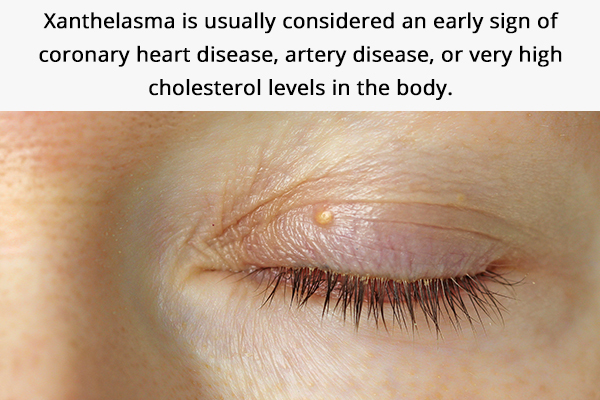
Xanthelasma is usually considered an early sign of coronary heart disease, artery disease, or very high cholesterol levels in the body.
If you or anyone you know have yellow growths around their eyes, it is necessary to get them evaluated by a doctor and undergo tests to properly diagnose the condition. (20)
Final Word
Xanthelasma is caused by cholesterol deposits around the eyes and is usually an indicator of lipid disorders.
Treatment for xanthelasma involves treating the underlying disorder. You may require the help of a dermatologist, dietitian, and general physician to completely rid yourself of this issue. (20)
- Was this article helpful?
- YES, THANKS!NOT REALLY


